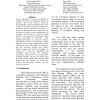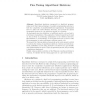5022 search results - page 170 / 1005 » Data structures and problem solving using Java |
HICSS
1999
IEEE
15 years 2 months ago
1999
IEEE
Legacy information systems are difficult to transform into the new or upgraded information systems. Part of the reason is being the incompatibility and the unscalability between t...
DOCENG
2003
ACM
15 years 3 months ago
2003
ACM
This paper reports some experiments in using SVG (Scalable Vector Graphics), rather than the browser default of (X)HTML/CSS, as a potential Web-based rendering technology, in an a...
110
click to vote
CP
2007
Springer
15 years 4 months ago
2007
Springer
While many real-world combinatorial problems can be advantageously modeled and solved using Constraint Programming, scalability remains a major issue in practice. Constraint models...
EUROPAR
2007
Springer
15 years 4 months ago
2007
Springer
Abstract. Algorithmic skeletons correspond to a high-level programming model that takes advantage of nestable programming patterns to hide the complexity of parallel/distributed ap...
EMNLP
2007
14 years 11 months ago
2007
In Sequential Viterbi Models, such as HMMs, MEMMs, and Linear Chain CRFs, the type of patterns over output sequences that can be learned by the model depend directly on the model‚...


